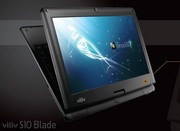Yukyung Viliv S10
Specifications

Price comparison
Average of 1 scores (from 2 reviews)
Reviews for the Yukyung Viliv S10
Source: Laptop Mag
 Archive.org version
Archive.org versionThe Viliv S10 Blade impresses with its resistive multitouch screen and slim form factor, but the tablet trips up when it comes to performance and usability. Also, $797 is a steep price to pay for mediocre performance, even with the long battery life. Users can find similar features and better performance in the Lenovo IdeaPad S10-3t, which costs $300 less. Overall, the S10 Blade creates the impression of a tablet that’s not quite ready nor yet worth the price.
Single Review, online available, Long, Date: 03/23/2010
Rating: Total score: 50%
Source: UMPC Portal
 Archive.org version
Archive.org versionThe S10 is another high quality product from Viliv and a convertible netbook with features and options that very few other devices can match. Battery life is fantastic for a 1.2KG device and the style makes the S10 even more unique. We question the usefulness of multitouch for the average user and feel that 1.2KG is too heavy for long-duration tablet use but at the end of the day, there’s no significant disadvantage to having multitouch or a tablet-capable design.
Single Review, online available, Long, Date: 03/21/2010
Rating: mobility: 80% workmanship: 80%
Comment
Intel Graphics Media Accelerator (GMA) 500: Integrated (onboard) graphics chip on the UL11L, US15L, and US15W chipsets with a licensed PowerVR SGX core. DirectX 10.1 support but because of low clock rates (100-200 MHz UL11L - US15) and only 4 shaders not suited for 3D games. The integrated video decoder accelerates the playback of HD videos (MPEG2, VC-1, AVC).
These graphics cards are not suited for Windows 3D games. Office and Internet surfing however is possible.
» Further information can be found in our Comparison of Mobile Graphics Cards and the corresponding Benchmark List.
Intel Atom: The Intel Atom series is a 64-Bit (not every model supports 64bit) microprocessor for cheap and small notebooks (so called netbooks), MIDs, or UMPCs. The speciality of the new architecture is the "in order" execution (instead of the usual and faster "out of order" execution). Therefore, the transistor count of the Atom series is much lower and, thus, cheaper to produce. Furthermore, the power consumption is very low. The performance per Megahertz is therfore worse than the old Pentium 3M (1,2 GHz on par with a 1.6 GHz Atom).
Z530:
Power saving version of the Atom N270 with additional Virtualization Support and more power saving techniques. The performance is equal to the N270 and therefore only suited for basic tasks.
» Further information can be found in our Comparison of Mobile Processsors.












